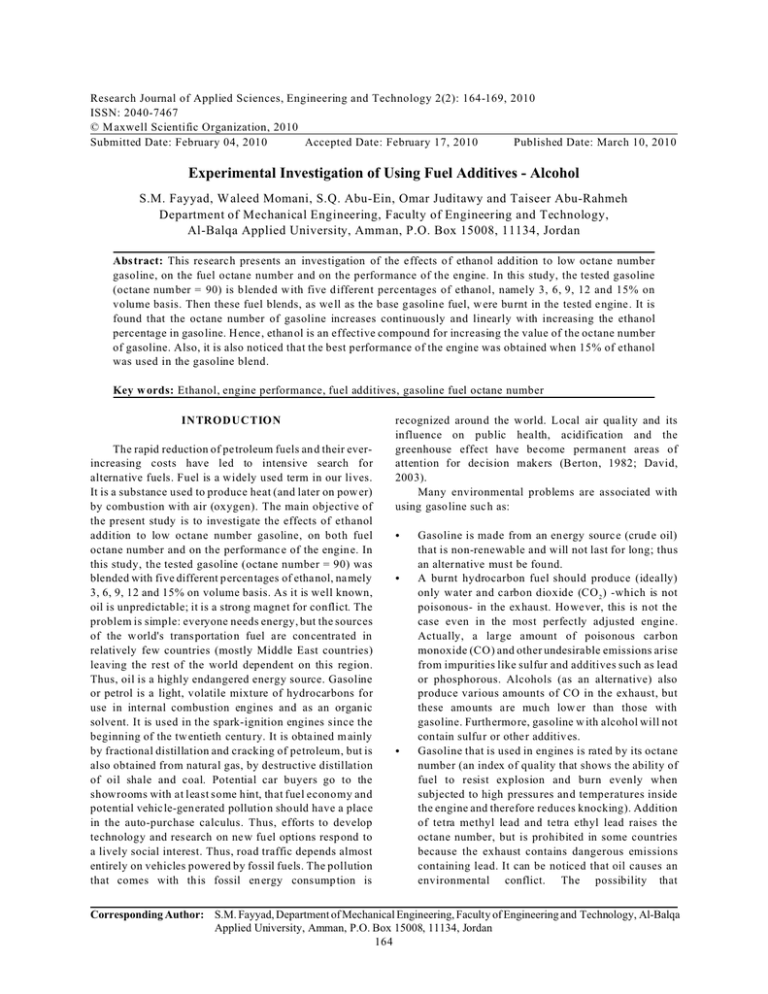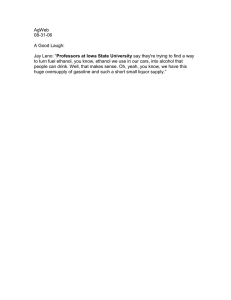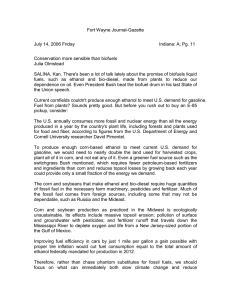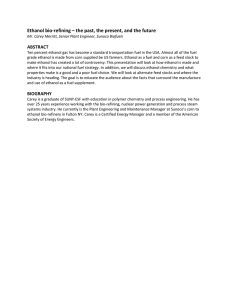Research Journal of Applied Sciences, Engineering and Technology 2(2): 164-169,... ISSN: 2040-7467 © M axwell Scientific Organization, 2010
advertisement

Research Journal of Applied Sciences, Engineering and Technology 2(2): 164-169, 2010 ISSN: 2040-7467 © M axwell Scientific Organization, 2010 Submitted Date: February 04, 2010 Accepted Date: February 17, 2010 Published Date: March 10, 2010 Experimental Investigation of Using Fuel Additives - Alcohol S.M. Fayyad, W aleed Momani, S.Q. Abu-Ein, Omar Juditawy and Taiseer Abu-Rahmeh Department of Mechanical Engineering, Faculty of Engineering and Technology, Al-Balqa Applied University, Amm an, P.O. Box 15008, 11134, Jordan Abstract: This research presents an investigation of the effects of ethanol add ition to low octane number gasoline, on the fuel octane number and on the performance of the engine. In this study, the tested gasoline (octane num ber = 90) is blende d with five different percentages of ethanol, namely 3, 6, 9, 12 and 15% on volume basis. Then these fuel blends, as we ll as the b ase gasoline fuel, w ere bu rnt in the tested engine . It is found that the octane number of gasoline increases continuously and linearly with increasing the ethanol percentage in gasoline. Hence , ethanol is an effective compound for increasing the value of the octane number of gasoline. Also, it is also noticed that the best performance of the engine was obtained when 15% of ethanol was used in the gasoline blend. Key w ords: Ethanol, engine performance, fuel additives, gasoline fuel octane number INTRODUCTION The rapid reduction of pe troleum fuels an d their everincreasing costs have led to intensive search for alternative fuels. Fuel is a widely used term in our lives. It is a substance used to produce heat (and later on pow er) by combustion with air (oxygen). The main objective of the present study is to investigate the effects of ethanol addition to low octane number gasoline, on both fuel octane number and on the performanc e of the engine. In this study, the tested gasoline (octane number = 90) was blended with five different percen tages of ethanol, namely 3, 6, 9, 12 and 15% on volume basis. As it is well known, oil is unpredictable; it is a strong magnet for conflict. The problem is simple: everyone needs energy, but the sources of the w orld's transportation fuel are con centrated in relatively few countries (mostly Middle East countries) leaving the rest of the world dependent on this region. Thus, oil is a highly endangered energy source. Gasoline or petrol is a light, volatile mixture of hydrocarbons for use in internal combustion engines and as an organic solvent. It is used in the spark-ignition engines since the beginning of the tw entieth century. It is obtained m ainly by fractional distillation and cracking of petroleum, but is also obtained from natural gas, by destructive distillation of oil shale and coal. Potential car buyers go to the showrooms with at least some hint, that fuel economy and potential vehicle-gen erated pollution sho uld have a place in the auto-purchase calculus. Thus, efforts to develop technology and research on ne w fuel options resp ond to a lively social interest. Thus, road traffic depends almost entirely on vehicles powered by fossil fuels. The pollution that comes with th is fossil en ergy consump tion is recognized aroun d the w orld. Local air quality and its influence on public health, acidification and the greenhouse effect have be come permanent areas of attention for decision makers (Berton, 1982; David, 2003). Many environmental problems are associated with using gasoline suc h as: C C C Gasoline is made from an energy source (crud e oil) that is non-renewable and will not last for long; thus an alternative must be found. A burnt hydrocarbon fuel should produce (ideally) only water and carbon dioxide (CO 2 ) -which is not poisonous- in the ex haust. However, this is n ot the case even in the most perfectly adjusted engine. Actually, a large amount of poisonous carbon monoxide (CO) and other undesirable emissions arise from impurities like sulfur and additives such as lead or phosphorous. Alcohols (as an alternative) also produce various amounts of CO in the exhaust, but these amo unts are mu ch low er than those with gasoline. Furthermore, gasoline w ith alcohol will not contain sulfu r or other additives. Gasoline that is used in engines is rated by its octane number (an index of quality that shows the ability of fuel to resist explosion and burn evenly when subjected to high pressu res and temperatures inside the engine and therefore reduces knocking). Addition of tetra methyl lead and tetra ethyl lead raises the octane number, but is prohibited in some countries because the exhaust contains dangerous emissions containing lead. It can be noticed that oil causes an environmental conflict. The possibility that Corresponding Author: S.M. Fayyad, Department of Mechanical Engineering, Faculty of Engineering and Technology, Al-Balqa Applied University, Amman, P.O. Box 15008, 11134, Jordan 164 Res. J. Appl. Sci. Eng. Technol., 2(2): 164-169, 2010 greenhouse gases will lead a catastrophic climate change is substantially increased by the 40 million barrels of oil burnt by vehicles every day, (David, 2003; Berton, 19 82). petroleum displac eme nt adv antag e, the use of E -diesel in urban buses is intended primarily to help reduce emissions of fine Particulate Matter (PM) and Oxides of Nitrogen (NO x); PM has been identified as an important direct health threat and NOx as an important precursor of tropospheric ozone. The application of E-diesel in farming tractors is viewed by the agricultural community as a means to use an agriculture-based fuel for farming activities. Tad (2006), defined sustainability and sustain able cyclic processes and quantified the degree of non-renewability of a major bio-fuel: ethanol produced from industrially grown corn. First, the paper demonstrated that more fossil energy is used to produce ethanol from corn tha n the ethano l’s calorific value. Analysis of the carbon cyc le shows that all leftovers from ethanol production must be returned back to the fields to limit the irreversible mining of soil humus. Thus, production of ethanol from whole plants is unsustainable. In 2004, ethanol production from corn has generated 11 million tonnes of incremental CO 2 , over and above the amount of CO 2 generated by burning gasoline with 115% of the calorific value of this ethanol. Second, it calculated the cumu lative energy (available free energy) consumed in corn farming and ethanol production, and estimated the minimum amount of work necessary to restore the key non-renewable resources consumed by the industrial cornethanol cycle. This amount of work was compared to the maximum useful work obtained from the industrial cornethanol cycle. It appeared that if the corn ethanol energy is used to power a car engine, the minimum restoration work is about 7 times the maximum useful wo rk from the cycle. This ratio drop s dow n to 2.4, if an ideal (but nonexisten t) fuel cell is used to process the ethanol. Third, the study estimated the U.S. taxpayer subsidies of the industrial corn-ethanol cycle at $3.3 billion in 2004. The parallel subsidies by the environment have been estimated at $1.9 billion in 2004. The latter estimate will increase manifold when the restoration costs of aquifers, streams and rivers and the Gulf of Mexico are also included. Finally, it estimated that (per year and unit area) the inefficient solar cells produce 100 times m ore electricity than corn ethanol needed to rely more on sunlight, the only source of renewable energy on earth (Sharma, 1994). Cole (2000) carried out an experiment on engine-out emissions from a Volkswagen model TDI engine. These emissions were m easured for three different fuels: neat diesel fuel, a blend of diesel fuel and additives containing 10% ethanol and a blend of diesel fuel and additives containing 15% ethanol. The test matrix covered five speeds from 1 ,320 to 3,000 rpm, five torques from 15 Nm to the maximum plus the 900-rpm idle condition, and most of the points in the FTP-75 and US-06 vehicle tests. Emissions of Particulate Matter (PM), Nitrogen Oxides (NOx), unburnt Hydrocarbons (HCs) and Carbon Monoxide (CO) were measured at each point, as were fuel Alternative Fuel: C The most important cause of searching for alternative fuels is the finite nature of crude oil resources that will vanish soon and will not last forever. Studies that have been conducted in this field showed that raw materials for energy such as petroleum have been depleted at an extremely rapid rate. About 80% of energy resources will be used up by the beginning of the 21st century. C The use of multi - spark, multi - valve, super or turbo-charged engines makes these engines ve ry complicated in design and increases cost, frictional losses and number of maintained components in the autom obile. C There is a neg ative effect of exhaust undesirable products tha t pollute air water, soil and ozone laye r. C Gasoline consists of a mixture of hydrocarbons extracted at differen t boiling temperatures and thus having different physical and chemical properties (some of its components are highly volatile causing problems in sum mer, w hile som e hav e low volatility causing cold starting in winter). This mak es it difficult to control the behavior of gasoline. C The world depends on oil for more than 30% o f its energy. Because reserves are unevenly distributed, many countries import much of their oil and so depend on the few places in the world where petroleum is abundant, mainly the M iddle E ast. Gasoline and diesel together provide 99% of the fuel consumed in road transport. This reliance on oil will not diminish in com ing decad es becau se petroleum remains abundant and cheap, and the energy consumption for transport will increase. Worldwide, automotive energy consumption reached an estimated 52.5 x 1018 J in 19 90, an d is projected to grow to 79 x 1018 J around the year 2025, (Hadder and Mcnutt, 1996). C Finally, the environmen tal burden po sed by oil consumption provides a powerful stimulus to reduce it. Vehicle technology can diminish most of the local and regional pollution from automotive fossil fuels, but increased greenhouse emissions remain inherent in their use, (Hadder and Mcnutt, 1996; Colledge, 1992; Doann, 198 2; M achiele, 1988). Many studies have discussed fuel additives. Michael et al. (2003), focused on urban transit buses and farming tractors, w hich are likely to be among the earliest commercial E-diesel applications. In past and current U.S. demonstration programs, buses and farming tractors have operated and still operate on E-diesel blends. Besides the 165 Res. J. Appl. Sci. Eng. Technol., 2(2): 164-169, 2010 consumption, exhaust oxygen, and carbon dioxide outpu t. PM emissions w ere reduced up to 75% when ethanoldiesel blend s we re used instea d of ne at diesel fuel. Significant reductions in PM emissions occurred over one-half to two-thirds of the test matrix. NOx emissions were reduced by up to 84%. Although the regions of reduced NOx emissions were much smaller than the regions of reduced PM emissions, there was a considerable overlap between the two regions where PM emissions were reduced by up to 75% and NOx emissions were reduc ed by up to 84%. Such simultaneous reduction of both P M and N Ox emissions w ould b e difficult to achieve by any other means. HC and C O em issions we re also reduced in the regions of reduced PM and NOx emissions that overlapped. Because ethanol-diesel blends contain less energy on both a per-unit-mass basis and a per-unit-volume basis, there was a reduction in the maximum torque of up to 10% and an increase in the brake-specific fuel consumption of up to 7% w hen these blend s we re used (Szware and Bran co, 19 85). Tad (2003) stated that ethanol is burnt as a gasoline additive or fuel. Burning the same amount of fuel twice to drive a car once is equivalent to halving the fuel efficiency of those cars that burn corn ethanol, and will cause man ifold damage to air, surface water, soil and aquifers. The overa ll energy balance of corn conversion to ethanol dem onstrates that 65% of the input en ergy is lost during the conversion. Carbon dioxide sequestration by corn is nullified when corn ethanol is burnt. Therefore, they conclude that subsidizing ethanol from corn as a gasoline oxygenate is one of the most misguided pu blic policy decisions made in the recent history. together with the cooling water tank. The color of the fuel tanks conforms to international regulations; red for petrol and brown for diesel fuel. Behind the panel is a viscous flow meter for measuring the air consumption of the engine and the radiator/fan unit used to cool the eng ine. Engine Specifications: Compression ratios: 5: 1 to 11: 1, Cylinder bore: 95 mm, Stroke: 82 mm , Swept volume: 582 cm 3 , Speed rang e: 1000 to 25 00 rpm, M ax power: 7 kW , Max torq ue: 50 N.m, Ignition timing: 30º B TD C to 10º A TD C, Chock sizes: 19, 21, 23, 25 mm C apacities: Engine oil: 2 l, Fuel tanks: 4.5 l, Cooling w ater reservoir: 1 l Filters: Air intake: AC2047, Petrol: ACD 60 or Crosland 489, Tappet oil: ACD60 or Crosland 311. Lubrication oil: A heavy duty lubricating oil is used . Fuel: Any grade of petrol or diesel oil may be used. LPG (Propane) with dry take off may be used when the engine is converted to run on gas. Typical specific gravity for petrol: 0.741, Typical calorific value for petrol: 42000 kJ/kg. RESULTS AND DISCUSSION Figure 1 shows that the brake torque of pure gasoline is less than that obtained with ethanol. The difference varies from 8 .47 to3 8.9% . It is further no ticed tha t with ethanol addition, maximum brake torque is obtained at higher speeds with a 15% blend. At lower to medium speeds, it is obtained with a 3% blend. Also, it can be noticed that ethanol addition of 9-12% gives the least brake torque among ethanol addition percentages. Figure 2 shows that pure gasoline gives again the lowest brake power. The highest power at higher engine speeds is reached using 15% ethanol blend, while at lower engine speeds 3 % etha nol blend gives higher brake pow er. The maximum rise in brake power is 38.9%. It occurs at 2250 rpm , while the minimum rise is 6.45% occurring at 1250 rpm. Com paring ethanol blends, we find out that a percentage of 9-12% gives the least brake pow er. Figure 3 shows that the brake mean effective power was highest when using 3% ethanol at medium engine speeds and when using 15% ethanol at low and high engine speeds. Pure gasoline gives the lowest mean effective pressure at all engine speeds. The maximum variation is 38.9% and occurs at 2250 rpm, while the minimum is 6.45% at 1750 rpm. It is shown in Fig. 4 that the thermal efficiency o f pure gasoline is the lowest at all engine speeds. The 15% ethanol blend gives the highest thermal efficiency, and the 9 - 12% ethanol blends give lower thermal efficiency. The maximum variation in thermal efficiency is 64.9% at 2250 rpm while the minimum one is 17.28% at 1000 rpm. From Fig. 5, the brake specific fuel consumption for pure gasoline increases with engine speed, and it is higher than for the other ethanol blends. At low engine speeds, the MATERIALS AND METHODS Experimental work: The experimental work of this study was performed using the TD43 test (these tests we re conducted in 2008, at university of Jordan, JUST, and FET laboratories in Jordan ), water-cooled four-stroke diesel engine, which has been further developed by TecEquipment to increase its versatility. The compression ratio may be varied between 5:1 and 11:1. N ormally aspirated, the engine will run on petrol, diesel, fuel and propane o r natural gas. The en gine is d irectly co upled to an electrical dynamometer. This is also used to start the engine and to turn the engine for friction power tests. Both the engine and dynamom eter are mou nted o n a rigid steel bedplate, which is free standing on four vibrationisolating feet. Two panels stand behind the engine and dynam ometer. The left hand panel contains the electrical controls for controlling the dynamometer in its motor and generator modes and the switches for loading the dynam ometer. The right hand panel houses the instrume nts for measuring the engine performance. Fuel tanks for petrol and diesel are mounted above the panel, 166 Res. J. Appl. Sci. Eng. Technol., 2(2): 164-169, 2010 Fig. 1: Brake mean effective pressure vs. engine speed Fig. 2: Brake power vs. engine speed Fig.3: Brake specific fuel consumption vs. engine speed minimum brake specific fuel consumption is that of the 9% ethanol blend. At higher speeds, it is minimum for the 15% ethanol blend. Among the ethanol blends, the maximum brake specific fuel consumption is that for 12% ethan ol. It is show n from Fig. 6 that the exhaust temperature increases with increasing the engine speed for the pure gasoline and the ethanol blends. The highest exhaust temperature is obtained for the 9% ethanol blend. The 15% ethanol blend gives the lowest temperature. Figure 7 shows that pure gasoline has minimum thermal efficiency and maximum brake specific fuel consumption. Also, it is noticed that the brake specific fuel consumption is inversely proportional to the thermal efficiency. Adding 15% ethanol gives the highest thermal efficiency and the 167 Res. J. Appl. Sci. Eng. Technol., 2(2): 164-169, 2010 Fig. 4: Brake torque vs. engine speed Fig. 5: Exhaust temperature vs. engine speed Fig. 6: Engine thermal efficiency vs. engine speed lowest brake specific fuel consumption. Comparing the ethanol blends, adding 9-12% ethanol gives the lowest thermal efficiency, hence, the highest brake specific fuel consumption. ethanol gives the best overall performance. For low speed engines, 6-9% ethanol addition gives good thermal efficiency and b rake specific fuel consumption , while 3% ethanol gives the best torque and mean effective pressure. For medium to high speeds, it is clearly shown that 15% ethanol gives the best performan ce. En ergy lost with exhaust tends to be least with 15% ethanol and most with 9-12% ethano l. CONCLUSION It is generally noticed that ethanol addition improves the performance of the engine. It is obvious that 15% 168 Res. J. Appl. Sci. Eng. Technol., 2(2): 164-169, 2010 Fig. 7: Thermal efficiency vs. percentage of ethanol added Machiele, P.A., 1988. Flamm ability and toxicity tradeoffs with methanol fuels. SAE paper No. 872064. Michael, W ., S. Chris and L. Hanjie, 2003. Fuel - cycle energy and emission impacts of ethanol - diesel blends in urban buses and farming tractors. Center for Transportation Research, Argonne National Laboratory. Illinois Department of Commerce and Economic Opportunity. Sharma, R.P., 1994. Internal combustion engines. Dhanpat Rai and S ons, N ai Sarak , De lhi. Szware, A. and G.M. Branco, 1985. Automotive use of alcohol in Brazil and air pollution related aspects. SAE paper number 850 390. Tad, W .P., 2003. Ethanol from corn: clean renewable fuel for the future, or drain on our resources and pockets. Environ. Dev. Sustain., Manuscript ENVI165-03N. Tad, W.P., 2006. Thermodynamics of the corn - ethanol bio-fuel cycle. Crit. Rev. Plant Sci., 23(6): 519-567. REFERENCES Berton, H., 19 82. The forb idden fuel, power alcohol in the 20th century. Boyd Griffen, Inc., NY. Cole, R.L., 2000. Effect of ethanol fuel additive on diesel emissions, A N L / E S D / T M - 1 6 2 . C e n ter for Transportation Research, Argonne N ational Laboratory. United States Department of Energy. Colledge, R., 1992. Methanol: meeting transportations fuel demand. CATF article No. 2121. David, P., 2003. Ethanol Fuels: energy balance, economics and environmental impacts are negative. Nat. Reso ur. Re s., 12(2). Doann, H., 1982. Alcohol Fuels. Westview Press / Boulder Colorado. Frazee, B., 1950. Automotive fundamentals. American Technical Society, Chicago, USA. Hadder, G.R . and B . Mcnutt, 1996. The poten tial for alcoh ols and related ether to displace conventional gasoline componen ts. Procee dings of the eleven th international symposium on alcohol fuels, Sun City, South Africa. 169





